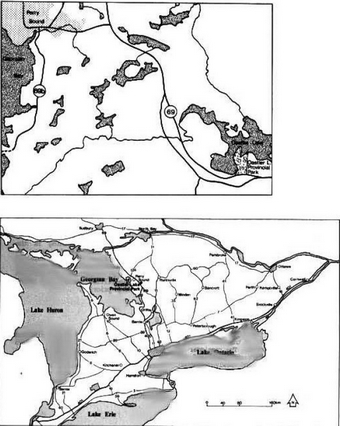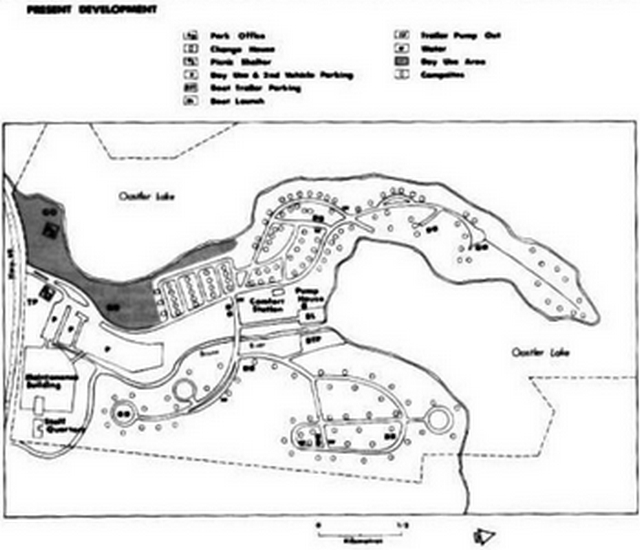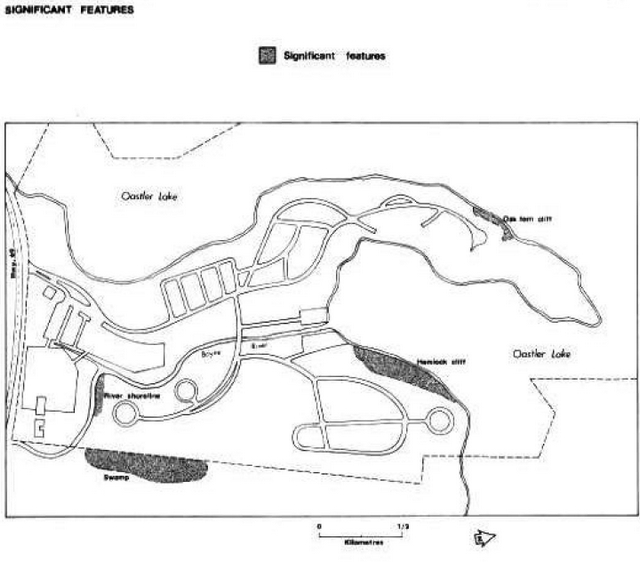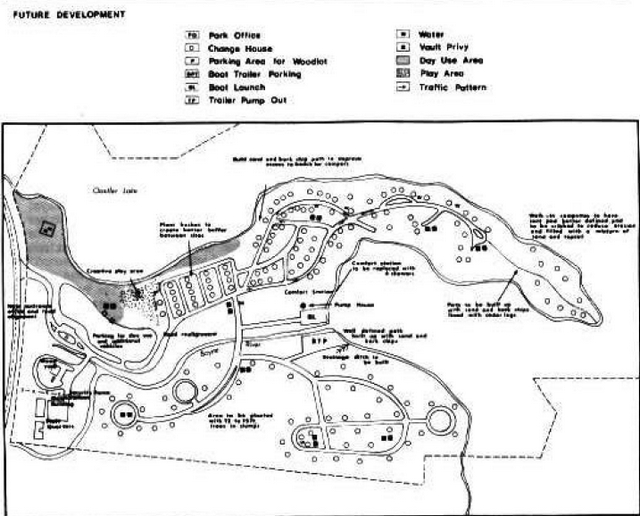Oastler Lake Provincial Park Management Plan
This document provides policy direction for the protection, development and management of Oastler Lake Provincial Park and its resources.
Park Management Planning Series
Oastler Lake Provincial Park Management Plan
MNR 3478
ISBN 0-7729-1028-6
©1986 Government of Ontario
Limited copies of this publication are obtainable at the Ministry of Natural Resources, Huntsville Regional Office, Box 9000, Huntsville, Ontario, P0A 1K0 705-789-9611; the district office at Parry Sound, 4 Miller Street, Parry Sound, Ontario, P2A 1S8, 705-746-4201; Oastler Lake Provincial Park, c/o 4 Miller Street, Parry Sound, Ontario, P2A 1S8, 705-378-2401
Approval statement
Oastler Lake Provincial Park provides access to Oastler Lake, one of the nest picturesque and rugged shorelines characteristic of the lake-studded Precambrian rock landscapes of the area. From the Park’s inception as a Department of Highways picnic site, campers, boaters and swimmers have come to use this Park as a focus for their favourite pastimes.
"We are pleased to approve the Oastler Lake Provincial Park Management Plan, as official policy for the management and development of this park. The plan reflects this Ministry’s intent to protect natural and cultural features of Oastler Lake Park and maintain and develop high quality opportunities for outdoor recreation and heritage appreciation for both residents of Ontario and visitors to the Province."
Regional Director
Algonquin Region
Director
Parks and Recreational Areas Branch
1.0 Introduction
Oastler Lake Provincial Park is located in the central portion of Foley Township, Parry Sound District. Highway 69 forms the Park’s southern boundary providing good road access f ran the large northern urban centres of Sudbury, North Bay, and Toronto to the south. The closest population centre is Parry Sound, located 7 kilometres northwest by road. The Park is centred 167 kilometres south of Sudbury and 224 kilometres north of Toronto.
The Park covers an area of approximately 32 hectares, which is virtually all developed.
Since 1967, when Oastler Lake Park was designated a provincial park under the Provincial Parks Act (Ontario Regulation 245/67) it has undergone many alterations in site design and number of facilities. The Park now contains 142 campsites featuring different types of camping from walk-in campsites to sites capable of handling tents or tent trailers to pull-through campsites for large trailers. There is a centrally located comfort station and ten pairs of vault privies or vault toilets with vanities. All other facilities including the ones mentioned are shown on Figure 2.
Oastler Lake Park and surrounding area is located on the Parry Sound Metavolcanic and Ontario Gneiss Segment of the Grenville structural province of the Precambrian Shield. Over one-half of the Park was once a swamp with the Boyne River flowing through it. This area has been filled in with sand and gravel and Boyne River rerouted. The remainder of the Park area exhibits many of the features typical of the Precambrian Shield such as rock outcrops and shallow soils.
A hemlock forest stand covers one-quarter of the park area with another one-quarter of the Park foliated in northern hardwoods. The remainder of Oastler Lake Park is comprised of cottonwood stands and newly planted stock on the landfill area.
The presence of Georgian Bay helps modify the climate compared to that expected further inland. The Park and surrounding area experiences a fair amount of precipitation, much of which falls as snow, producing one of the heaviest snowfall areas in southern Ontario. The summer day temperatures are warm and evenings cool, creating perfect weather conditions for summer outdoor recreation.
2.0 Summary of significant issues
There are five distinctly different campground areas within the Park, which vary in quality and contain in various degrees, maintenance and/or design problems.
Sate campsites are showing signs of site deterioration due to high campsite densities and heavy use. Trampling of the soil and damage to the tree roots is causing slow deterioration of the area tree stands as well as erosion problems on campsites.
In many instances natural buffers between campsites are either non-existent or of poor quality. These buffers are needed to provide some form of privacy between campsites.
With the general trend of longer average stays (3.4 days, 1983-84), consideration will be given to upgrade sanitary facilities. Accompanying this trend of visitors staying longer is the problem of bathing. For instance without showers, the only location for bathing is the lake. However, the lake’s size and activities upstream could cause a lowering of water quality thus making it impossible to allow bathing. The addition of shower facilities should be looked upon as a high priority.
3.0 Classification
Oastler Lake Provincial Park’s size and amount of development, close to 95 percent of the Park’s area, dictates that it will continue to be classified as a Recreation Park. Recreation Parks are areas, which support a wide variety of outdoor recreation opportunities for large numbers of people in attractive surroundings.
Figure 1: Regional context

Enlarge Figure 1: Regional context
Figure 2: Present development

4.0 Goal
The Park goal will be to provide and maintain a quality summer oriented camping and day use facility within the context of recreation classed parks for both destination and stopover campers.
5.0 Objectives
Oastler Lake Provincial Park contributes to the achievement of the recreation, heritage appreciation and tourism objectives for the Park system.
5.1 Recreation objective
- To provide day use opportunities in areas of outstanding recreational potential
- To provide facility-based camping opportunities in areas of outstanding recreational potential
Oastler Lake Provincial Park will provide a safe, good quality beach and swimming area and a varied facility-based camping experience from walk-in campsites to car campsites able to accommodate tents and/or trailers. Boat access to Oastler Lake will also be provided. This Park provides the following recreation opportunities:
- 10,000 swimming
- 110,000 picnicking and
- 132,000 camping opportunities
5.2 Heritage appreciation objective
To provide opportunities in Ontario for exploration and appreciation of natural and cultural environments and a visitor services program based upon the character and significance of recreation Parks.
By reason of its size and amount of development in Oastler Lake Provincial Park, modest emphasis of its natural and cultural environments will be stressed. However, the information component of the visitor services program will emphasize recreation resources of the Park and surrounding area, as well as the Provincial Parks system.
5.3 Tourism objective
To provide Ontario residents and out-of-province visitors with opportunities to discover and experience the distinctive regions of the province.
Oastler Lake Provincial Park will continue to provide good quality camping and day use facilities with direct access from Highway 69 for those travelling through this portion of Ontario as well as destination camping for those attracted from considerable distances.
6.0 Zoning
Due to the Park’s size, the amount of development, which has taken place thus far, plus the lack of any large naturally significant area, the entire Park will be zoned development (Figure 3). However, there are three small natural areas (Figure 3) that contain locally significant species. A small section along the banks of the Boyne River contain sate interesting plant species such as the spatutate-leaved sundew, bog clubmoss and laced-leaved violet along with a variety of sedges, willow and royal fern. The Oak Fern Cliff and Hemlock Cliff include ferns and wild flowers of local significance. The Oak Fern Cliff site supports a flora of rock polypody fern, oak fern, speckled alder and sensitive fern. Eastern hemlock dominates the Hemlock Cliff site while the understory consists of polypody fern, yew, painted trillium and pink lady slipper.
Although these features are of local significance only, they are prominent interpretive assets to the Park. These areas will be treated with special attention. No development will be allowed with the exception of trails if feasible.
7.0 Resource management
The Park’s natural and cultural resources will be managed according to the administrative policies for resource management in Recreation Parks.
Figure 3: Significant features

7.1 Vegetation
Based on an objective of quality vegetation cover, a vegetation management plan has been written for the entire Park. The vegetative management goal in this plan is to maintain or establish vegetation throughout the Park suitable to the site, aesthetically pleasing to the user and functional in design (Secker, 1984).
Reforestation will be sustained in the development zone to create effective buffer areas between campsites where appropriate. The dominant overstay species in the four campground areas will be maintained. Vegetation species that have not been able to establish themselves will be replaced by species that are more suitable.
Rehabilitation of areas devoid of natural regeneration growth will also be carried out. Suitable tree and shrub species that are congenial to the dry, sandy soil of the landfill should be established to develop buffers and an overstory of trees for the provisions of sate shade to campsites fully exposed to sunlight.
Vegetation cover in the beach, day use and play areas will be augmented in a park-like setting with consideration for expansion of day use facilities at a future date.
The three life science features (Figure 3) of significance within the Park boundary described in Section 6.0, Zoning, will be allowed to progress through natural succession.
Some management practices will produce small quantities of wood as by-products of selective and dead tree removal. The wood, depending on the type and quality, can be used for firewood, sawlogs, posts or other required items. By this means, small savings in both maintenance and capital costs may be realized.
However, it must be remembered that the main purpose of these management techniques is to maintain or create a particular quality of vegetation and not to generate revenue.
7.2 Wildlife
No hunting will be allowed.
Trapping for nuisance beaver only will be permitted if necessary. However, because of the Park’s characteristics, beavers have not been a problem in the past.
7.3 Fisheries
No fisheries management programs are administered in the Park. However, the possibility to enhance angler success on Oastler Lake should be pursued within the Fish and Wildlife Section.
7.4 Fire
Normal fire detection and suppression will be carried out to protect park resources.
7.5 Insect and disease
Measures for insect and disease control will be permitted throughout the Park when necessary, for aesthetic purposes or if hazardous to park visitor health.
7.6 Water
Water quality will be monitored by the Park. The detection of problems will be investigated by this Ministry and Ministry of the Environment.
8.0 Visitor services
8.1 Information
Information on recreation resources of the Park and surrounding area as well as the provincial park system will be stressed. Providing information on local events and activities, park programs, changes in facilities and park rules will also be a priority.
A low priority will be given to providing information on natural and cultural features of the Park due to the general lack of significant areas. However there will be an attempt to inform park visitors of the surrounding area’s natural and cultural features as well as the three special natural areas in the Park. Cultural and recreation resource information, as well as Park programs and facilities will be provided in the Park brochure, displays and by informed park staff as well.
8.2 Interpretation
Park interpretation will be limited to self-use activities. Special programs during the summer season may be presented by the interpretive staff from Killbear Provincial Park or the District Office.
8.3 Recreation
Emphasis will be placed on informing and providing the park visitor with recreational facilities and activities within the Park. Fishing in Oastler Lake and the Boyne River, creative playground, horseshoe pits and beach are self-use facilities and part of the outdoor recreation component.
8.4 Marketing
Oastler Lake Park operates at a high occupancy rate. The average stay is lengthy (3.4 days), indicating that Oastler Lake is more than just a stopover park. Statistics convey that this Park is more popular with senior citizens and attracts a high percentage of visitors f ran United States in comparison to the rest of the parks in the region.
In 1979 visitor expenditures within 40 kilometres of Oastler Lake Provincial Park totaled $979,661. The total output generated by day use, campers and Ministry expenditures associated with Oastler Lake amounted to $1,277,341. Park visitors alone spent an average of $23.94 per day within the 40 kilometre radius of the Park.
The Park has excellent potential during the months of May, June and September for increasing camper use. The redesign of a small comfort station with showers, the replacement of vault privies with flushing toilets (where possible) and the restructuring of campsites would lengthen the stay of many visitors.
A marketing plan to attract more visitors to Oastler Lake throughout its operating and shoulder seasons will be prepared with the following objectives:
- to hold present clientele, to attract campers in the shoulder seasons (spring and fall)
- to increase involvement with the commercial sector by encouraging park users to utilize local tourist services and attractions, and
- generally stimulate interaction between the Park and the private tourist and commercial sector in the vicinity
9.0 Development
The future development strategy for Oastler Lake Provincial Park will be to retain the Park as is with minor modifications to facilities and services. These alterations will improve the qualities of both the physical environment and visitor’s stay. With the general trend of longer average stays, the existing comfort station will either be replaced with a new building or upgraded to incline facilities that now exist plus the addition of showers.
The majority of vault privies have been upgraded to incline vanities with basins and flush-o-matic style toilets. Those vault privies that have not been upgraded should be 'when and where appropriate. Consideration should also be given to provide electrical power to these facilities thus making it possible for low energy lighting and demand style hot water system. Such improvements will lessen the demand on the comfort station and tile bed.
The existing park entrance area will be eliminated and a new office will be designed and built containing an office for the Park Superintendent, coupled with roan provided for administrative and permit selling functions.
In designing the new park entrance complex, the Park’s main access road will be rerouted along the eastern side of the existing day use parking lot (Figure 4). This will create the necessary area to construct a larger parking lot adjacent to the day use area ruling out the problem of road crossing. This new lot will be large enough to accommodate appropriate day use (96 vehicles) and additional vehicle parking requirements.
Landscaping to create a vegetation screen between the parking lot and main access road will also be carried out for aesthetic reasons.
A creative playground will be constructed of natural materials such as wood, logs and hemp rope. The play area will be designed in a linked configuration containing a series of climbing devices, balance beam, obstacles, unconventional swings and slides, which will activate the communicative, emotional and physical attributes of a child.
Figure 4: Future development

The playground will be situated in an area south of the pull—through trailer sites (Figure 4). Campsite 5 will be removed to contribute to space to the play area.
The beach at the west side of the Park will, continue to be the main bathing area of the Park. Sand will be added from a source outside the Park and/or f ran the dry beach, to maintain sand sufficient for wet beach activities, as well as regulating aquatic plant growth.
The boat launching facilities will be relocated to the boat and trailer parking area (Figure 4), eliminating the annoyance of boat launching west of the Boyne River and trailer parking on the east side. This proposal will occur when the existing boat launching facilities need major upgrading or replacing.
10.0 Implementation strategy
The management plan will be reviewed not less than every ten years following its approval and as need arises. Data collection and environmental monitoring will be conducted regularly. Development will occur in accordance with approved site and development plans.
Below is a list of projects that have been previously described in this plan. The list appears in chronological order according to the individual project priority. The number of projects to be completed or partially completed will be based upon the availability and allocation of each year’s capital funding.
| Priority Rating | Project Description |
|---|---|
| 1 | Comfort station shower building |
| 2 | Upgrade vault toilets and privies |
| 3 | Landscaping and Planting following guidelines outlined in the Oastler Lake Vegetation Management Plan (Secker, 1984). |
| 4 | Market Management Plan |
| 5 | Creative Playground/Picnic Area |
| 6 | Campsite rehabilitation plan |
| 7 | Park entrance complex and day use area |
| 8 | Relocation of boat launching facilities. |
11.0 Public consultation
A preliminary management plan was written and made available to park visitors, adjacent landowners and local township offices to be reviewed and commented on.
Very few comments were received. Most are in agreement of what was being proposed.
12.0 References
Dickson, H.L. A Reconnaissance Life Science Inventory of Oastler Lake Provincial Park, Ontario Ministry of Natural Resources, Algonquin Region May 1977.
Ontario Ministry of Natural Resources, Algonquin Region Visitor Services Strategy, 1977.
Ontario Ministry of Natural Resources, Economic Impact of Provincial Parks in Ontario: A Summary Report Parks and Recreational Areas Branch, 1979.
Ontario Ministry of Natural Resources. 1978 Provincial Park Day Use Survey Summary Statistical Report , Parks and Recreational Areas Branch, 1979.
Ontario Ministry of Natural Resources. 1978 Provincial Park Camper Survey Summary Statistical Report , Parks and Recreational Areas Branch, 1979.
Ontario Ministry of Natural Resources, Parry Sound District Land Use Guidelines, Regional Lands Office
Ontario Ministry of Natural Resources. Provincial Park Statistics. Toronto, Division of Parks 1974-1984.
Secker, P.W. Vegetation Management Plan for Oastler Lake Provincial Park, Second draft. Ontario Ministry of Natural Resources, Parry Sound, 1984.